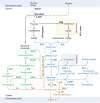Engineering yeast for tailored fatty acid profiles
- PMID: 40263140
- PMCID: PMC12014800
- DOI: 10.1007/s00253-025-13487-1
Engineering yeast for tailored fatty acid profiles
Abstract
The demand for sustainable and eco-friendly alternatives to fossil and plant oil-derived chemicals has spurred interest in microbial production of lipids, particularly triacylglycerols, fatty acids, and their derivatives. Yeasts are promising platforms for synthesizing these compounds due to their high lipid accumulation capabilities, robust growth, and generally recognized as safe (GRAS) status. There is vast interest in fatty acid and triacylglycerol products with tailored fatty acid chain lengths and compositions, such as polyunsaturated fatty acids and substitutes for cocoa butter and palm oil. However, microbes naturally produce a limited set of mostly long-chain fatty acids, necessitating the development of microbial cell factories with customized fatty acid profiles. This review explores the capabilities of key enzymes involved in fatty acid and triacylglycerol synthesis, including fatty acid synthases, desaturases, elongases, and acyltransferases. It discusses factors influencing fatty acid composition and presents engineering strategies to enhance fatty acid synthesis. Specifically, we highlight successful engineering approaches to modify fatty acid profiles in triacylglycerols and produce tailored fatty acids, and we offer recommendations for host selection to streamline engineering efforts. KEY POINTS: • Detailed overview on all basic aspects of fatty acid metabolism in yeast • Comprehensive description of fatty acid profile tailoring in yeast • Extensive summary of applying tailored fatty acid profiles in production processes.
Keywords: Cell factory; Fatty acid; Lipid; Metabolic engineering; Renewable resources; Yeast.
© 2025. The Author(s).
Conflict of interest statement
Declarations. Ethical approval: This mini-review does not contain any studies with human participants or animals performed by any of the authors. Conflict of interest: The authors declare no competing interests.
Figures


Similar articles
-
A mass spectrometry-based high-throughput screening method for engineering fatty acid synthases with improved production of medium-chain fatty acids.Biotechnol Bioeng. 2020 Jul;117(7):2131-2138. doi: 10.1002/bit.27343. Epub 2020 Apr 8. Biotechnol Bioeng. 2020. PMID: 32219854
-
Expression of cocoa genes in Saccharomyces cerevisiae improves cocoa butter production.Microb Cell Fact. 2018 Jan 25;17(1):11. doi: 10.1186/s12934-018-0866-2. Microb Cell Fact. 2018. PMID: 29370801 Free PMC article.
-
Multidimensional Metabolic Engineering for Constructing Efficient Cell Factories.Trends Biotechnol. 2020 May;38(5):468-469. doi: 10.1016/j.tibtech.2020.02.011. Epub 2020 Mar 19. Trends Biotechnol. 2020. PMID: 32302578
-
Recent advances in genetic engineering and chemical production in yeast species.FEMS Yeast Res. 2025 Jan 30;25:foaf009. doi: 10.1093/femsyr/foaf009. FEMS Yeast Res. 2025. PMID: 40082732 Free PMC article. Review.
-
Engineering Yarrowia lipolytica to Produce Tailored Chain-Length Fatty Acids and Their Derivatives.ACS Synth Biol. 2022 Aug 19;11(8):2564-2577. doi: 10.1021/acssynbio.2c00305. Epub 2022 Jul 31. ACS Synth Biol. 2022. PMID: 35912582 Review.
References
-
- Ambroziak J, Henry SA (1994) INO2 and INO4 gene products, positive regulators of phospholipid biosynthesis in Saccharomyces cerevisiae, form a complex that binds to the INO1 promoter. J Biol Chem 269:15344–15349 - PubMed
-
- Ando T, Inomata S, Yamamoto M (2004) Lepidopteran sex pheromones. In: Schulz S (ed) The chemistry of pheromones and other semiochemicals I. Springer, Berlin, Heidelberg, pp 51–96. 10.1007/b95449
Publication types
MeSH terms
Substances
LinkOut - more resources
Full Text Sources

